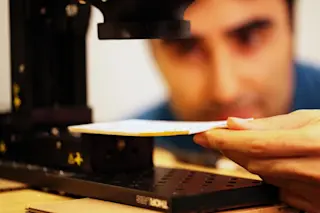A researcher tests out the new terahertz imaging system. (Credit: Courtesy Barmak Heshmat) You still can’t judge a book by its cover, but it’s possible to read one without ever opening it. That certainly adds a new wrinkle to an age-old idiom. But it’s true; researchers at MIT and Georgia Tech built a prototype — key word prototype — imaging system that can read individual pages in a stack of papers. It’s an early demonstration, so we’re talking a stack of only nine pages, but it’s a start. And as the technology improves, it could someday give, say, museum curators, another tool to study ancient, fragile books they wouldn’t dare open.
To peer through stacks of paper, the system relies on terahertz radiation, which is a frequency band of electromagnetic radiation that falls between microwaves and infrared light. Terahertz imaging systems emit short bursts of radiation that can penetrate a ...














